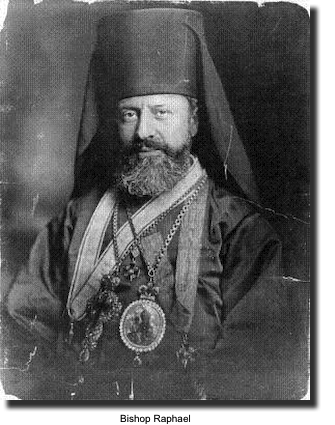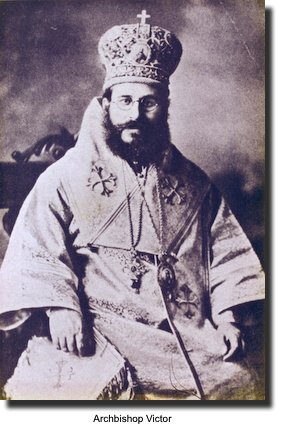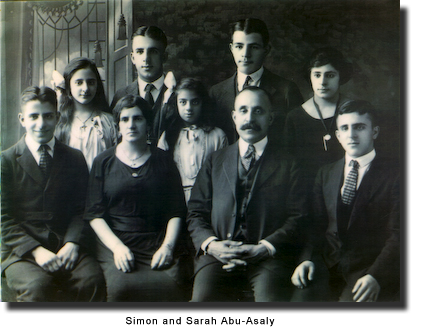Home>North America>Life of AB Gregory
Chapter 1: Early History
Archbishop Gregory was born to an illustrious Orthodox family, which is known in Lebanon and Syria by the name Abu-Asaly (father of honey). This large family traces its roots from a famous tribe called the Ghassanis, which emigrated from The Yemen in the 7th century AD, and settled in the regions of Damascus, all of them Christians.
As we know from the lives of the martyred saints Al-Harith and Elesvan (523), the Christian presence in southern Arabia had been marked by much persecution, first from the Jews as at the time of the above saints, and later by the onslaught of Islam. When Islam was demanding conversion, exile or death from all the inhabitants of southern Arabia, the Christians comprising the tribe of the Ghassanis chose exile and migrated north to Syria.
In Byzantine times, under the Emperor Justinian, this Orthodox Christian tribe protected the southern flank of the Byzantine Empire. When Moslem armies invaded Syria, many of these people who migrated from The Yemen were again forced to accept Islam or remain Orthodox as a subjugated people. It was very difficult for all Christians under the Islamic yoke, and those of the Ghassanis who did not become converts to Islam lived in a debased position in that society. The position was that of a conquered people, and they had to pay tribute and were subject to Islamic persecution and belligerence for hundreds and hundreds of years.
A great multitude, including the Abu-Asaly family, did not accept Mohammedanism, remaining Orthodox Christians under the Antiochian Patriarchate. When the Monophysite heresy spread throughout Syria, many of the Ghassanis fell away from the Church, but the Abu-Asaly family did not.
After the Crimean War in 1856, tensions were high in Syria and there was great fear among the Orthodox Christians. A massacre broke out on July 9, 1859, when the Moslems began a genocide to wipe out the Christian villages of Rashaia and Hasbaia. Archbishop Gregory‘s grandfather Simon was two months old at the time, living in the next village of Muhaidtha. One person escaped from the massacres and ran to Muhaidtha to warn the Christian people. Simon‘s uncle was in the field farming when he heard that the Moslems were on a rampage and were coming. He dropped his tools and picked up his two nephews, and ran and ran, literally, with the two boys, fleeing to the next big city, and safety. He left everything—his home and all his belongings, and ran for his life to the west to the safety of Beirut.
With the continued onslaught of Moslem and Turkish persecution prior to World War I, some of the Abu-Asaly family migrated to the United States. When Archbishop Gregory‘s grandfather Simon came to America in 1880 through Ellis Island, as usually happens, if the last name is too complicated for the registration clerk to spell, he took his middle name and made it his last name. Thus, Archbishop Gregory‘s grandfather‘s name was Simon George Abu-Asaly, and when he came into the country, his last name became George. He legally was known as Simon George, and settled in Worcester, Massachusetts. He was one of the founders of St. George Orthodox Church in Worcester, one of the first Orthodox churches in the United States.
To serve the many Syrian Orthodox Christians in this country, Bishop Raphael (Hawaweeny) was ordained by the future Patriarch of Russia and New-Martyr St. Tikhon, then Archbishop of the Russian Orthodox Church in America, and Bishop Innocent (Pustynskii). With the blessing of the Holy Synod, and by order of Tsar-Martyr St. Nicholas, Bishop Raphael was ordained on March 12, 1904. Bishop Raphael thus became the first Orthodox bishop to be consecrated in North America. Bishop Raphael fell asleep in Christ on February 27, 1915, at the age of fifty-four.

Before he was elevated to the episcopacy, Bishop Raphael performed the marriage of Simon George and the Orthodox handmaiden of God, Sarah, in New York City in 1897. The Syrians in this country remained under the Russian Orthodox Church up until the Communist Revolution.
After Patriarch Tikhon was killed and Communism began to take hold within the Russian Church in Russia, the Antiochian Patriarchate, to protect the Syrian Orthodox Christians in America, sent Archbishop Victor Abu-Asaly to the United States to put the Syrian people under the Patriarchate of Antioch. Archbishop Victor was Simon George‘s first cousin (their fathers were brothers). Archbishop Victor was consecrated to the episcopacy in 1924 and was sent to Massachusetts, where he lived until April 19, 1934, when he fell asleep in the Lord.
Prior to World War I, Archbishop Gregory‘s grandmother Sarah visited her dying father in Syria. While she was there, the war broke out, and she was not able to return to America until it ended. During all this time she was under the protection of the Patriarchate, and especially under the care of Fr. Victor Abu-Asaly. Father Victor was at that time a deacon, and taught the children whose fathers were massacred by the Turks at the orphanage adjacent to the Patriarchate. He provided Sarah with food and work, for she was a seamstress. She had traveled to Syria, and the total time of her separation was about six years.

Simon and Sarah George had four sons and three daughters. One of his sons was David, and he settled in the Boston area and married the Orthodox handmaiden of God, Agnes.

In 1944, the fruit of their love produced fraternal twins, Simon (Richard) and the future Archbishop Gregory named George. Their father David was a carpenter and said his prayers every day. He nurtured piety in his sons, as his father Simon did in him.
|
Archbishop Gregory Dormition Skete P.O. Box 3177 Buena Vista, CO 81211-3177 USA |

|
|
|
Copyright 2011 - Archbishop Gregory Last Updated: July 12, 2011 |
